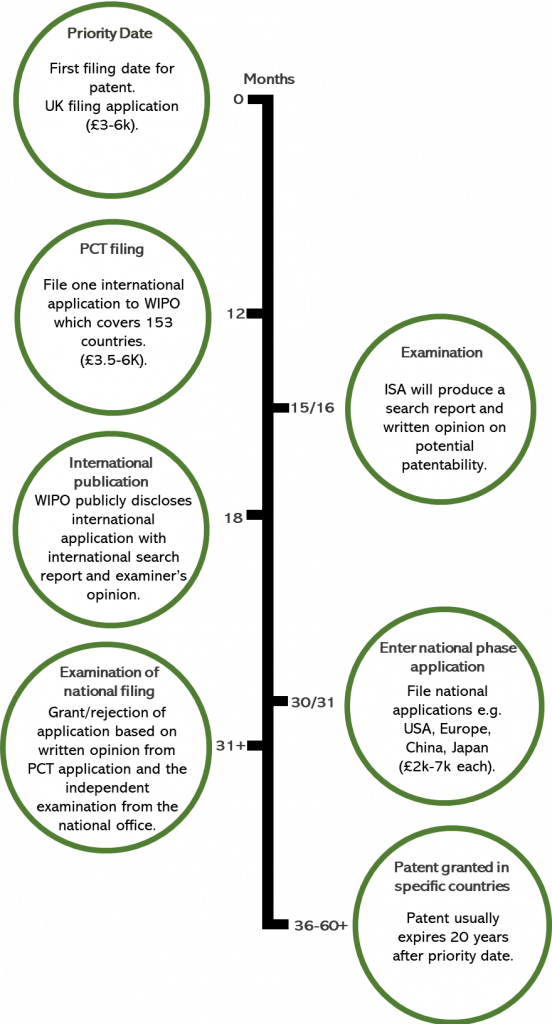What is patent filing and invention protection?
A patent is a form of intellectual property (IP) that is designed to protect but also encourage innovation. Essentially it is a bargain between an inventor and the government whereby in return for fully disclosing an invention, the government prohibits others from making, using or selling the invention, giving monopoly rights to the inventor for 20 years.
For an invention to be patentable, it must have fulfil several requirements:
- It must be novel. The invention has not been disclosed to the public prior to application. This means anything from a presentation/poster at a conference to a published article.
- It must not be obvious. Meaning it must have an inventive step that is not obvious to someone with expertise in the field.
- Utility. The infection has a technical application.
- Fully disclosed. The invention must be described with sufficient detail that would allow someone skilled in the field to replicate the invention.
How long is the patent process?
The entire process on average can take from 3-5 years from the initial date of filing to approval. Filing a patent is very costly and each step of the process can cost several thousand pounds. The common patent application method is through the Patent Co-operation Treaty (PCT) as it saves applicants time and money. The process is as follows:
- Filing a priority patent application (usually country of residence, European office or the US). The date in which the patent was filed and disclosed to the patent office is called the ‘priority date’. This date is important because it is at this point that your invention becomes known to the patent offices and the process of securing protection starts. Once a patent is filed, you can disclose technology to others through publication or presenting. It is also important to gather all necessary data which might be missing from the patent application at this point. These can be added to the application up until the 12 months from the priority date.
- After 12 months from priority date, it is common to file a PCT (Patent Cooperation Treaty) application which allows streamlined application in participating countries.
- Once PCT application is filed, the next step will be for the International Search Authority (ISA) to identify any published patent documents and technical literature relevant to the invention and provide a written opinion on the invention’s potential patentability. The documents identified are often referred to as ‘prior art’. After 18 months following the priority date, the content of the PCT application and the written opinion will be disclosed to the world.
- At 30/31 months from priority date (the end of the PCT procedure), regional/national patents need to be filed. The application is then examined by the individual regional/national offices and as a result a bundle of national patents is prosecuted and granted.

Do you want to license your technology or create a spin-out company?
The most common question we are asked is whether technology or service should be licensed or whether a spin-out company should be set up to commercialise the technology and what is better? The answer will depend on the specifics of your technology and its commercial potential and many factors need to be considered when deciding to license or spin-out.
The table below summarises the indicators which might point specific technologies towards the spin-out or licence routes.
| License | Spin-out |
|---|---|
| Technology can easily be produced on a commercial scale and sold by organisations with expertise in the field. | The current technology has completely different concepts from existing commercial technologies and cannot easily be manufactured or developed by external organisation. |
| Technology can be an extension of commercially available products on the market. | The technology is at an early stage of development with the potential of generating more IP and value prior to licensing. |
| The IP position of the technology is specific, normally generating a single product or a product range which cannot be further developed. | It’s a ‘platform’ technology where it has multiple applications and is more logical route than granting numerous licenses. |

What is the nature of licensing and spin-out
Licensing a technology is generally an easier and quicker route to commercialisation than forming a spin-out company. Once a license agreement is put in place, academics tend to have minimal input and the licensed technology is maintained by Chariot Innovations and the external organisation with a stream of revenue to the inventors. As existing licensee companies possess greater resources and expertise in product development, the licensed technology is likely to capture a larger market share, but also reach the market in a shorter time. Another benefit to researchers licensing their technology is the development of industry relationships that can enhance their research and teaching and potentially lead to further inventions.
Contrary to licensing which is a more ‘deal done, sit back and relax’ approach, forming a spin-out company requires an ongoing hands-on effort as academic founders pursue further investment and focus on company development. The amount of involvement needed is often the ultimate decision factor for researchers deciding between the license or spin-out route for their technology. This is not to suggest that forming a spin-out should be avoided, as it can lead to a greater return to the founding researcher, if successful. However, inventors should consider if they are ready to make the time commitment necessary to develop their venture, with likely gradual reduction in university involvement as the spin-out progresses.

Do I need a Business Plan?
Every idea sounds great at first. However, to really envisage how your company will operate and address a product or service to a market with an unmet need and convince investment, you will need to create a business plan.
A business plan is a written document which describes the company, its core activities, its defined development milestones and how it will go around achieving those milestones. Investors want to see that you have considered all factors necessary to make a business work and have the skillset required to pull-it off before they invest money into you and your idea. No two business plans are the same, though when writing a plan there are common sections all business plans include, such as such as market analysis, business model, financial plan and milestones.
A great tool to systemically review your business structure and strategy is to use a business model canvas (BMC), that was originally proposed by Alexander Osterwalder in 2005. This offers a visual way of breaking down the business into single elements including the product’s value proposition, infrastructure, customers, and finances.
You can find out more information on writing a business plan and BMC here.


